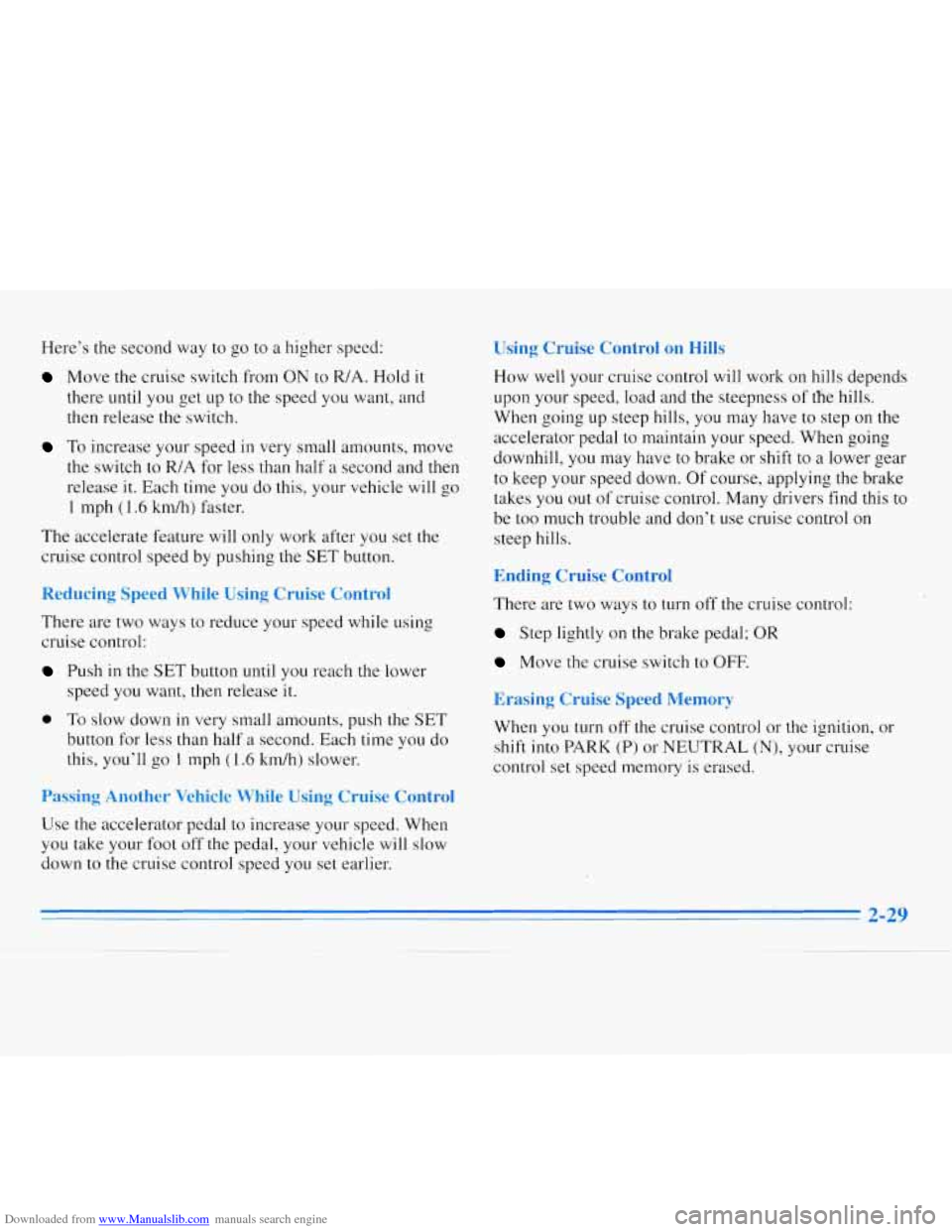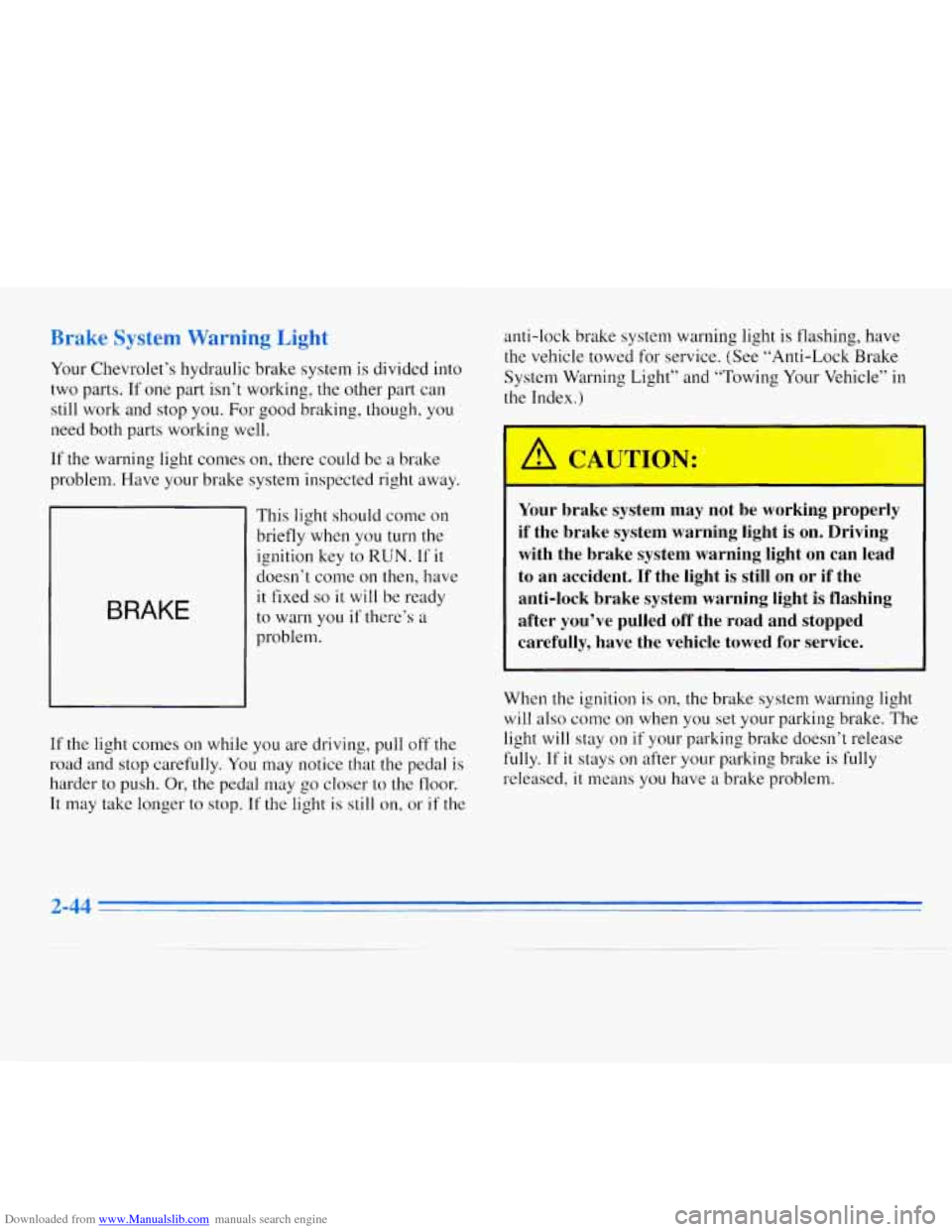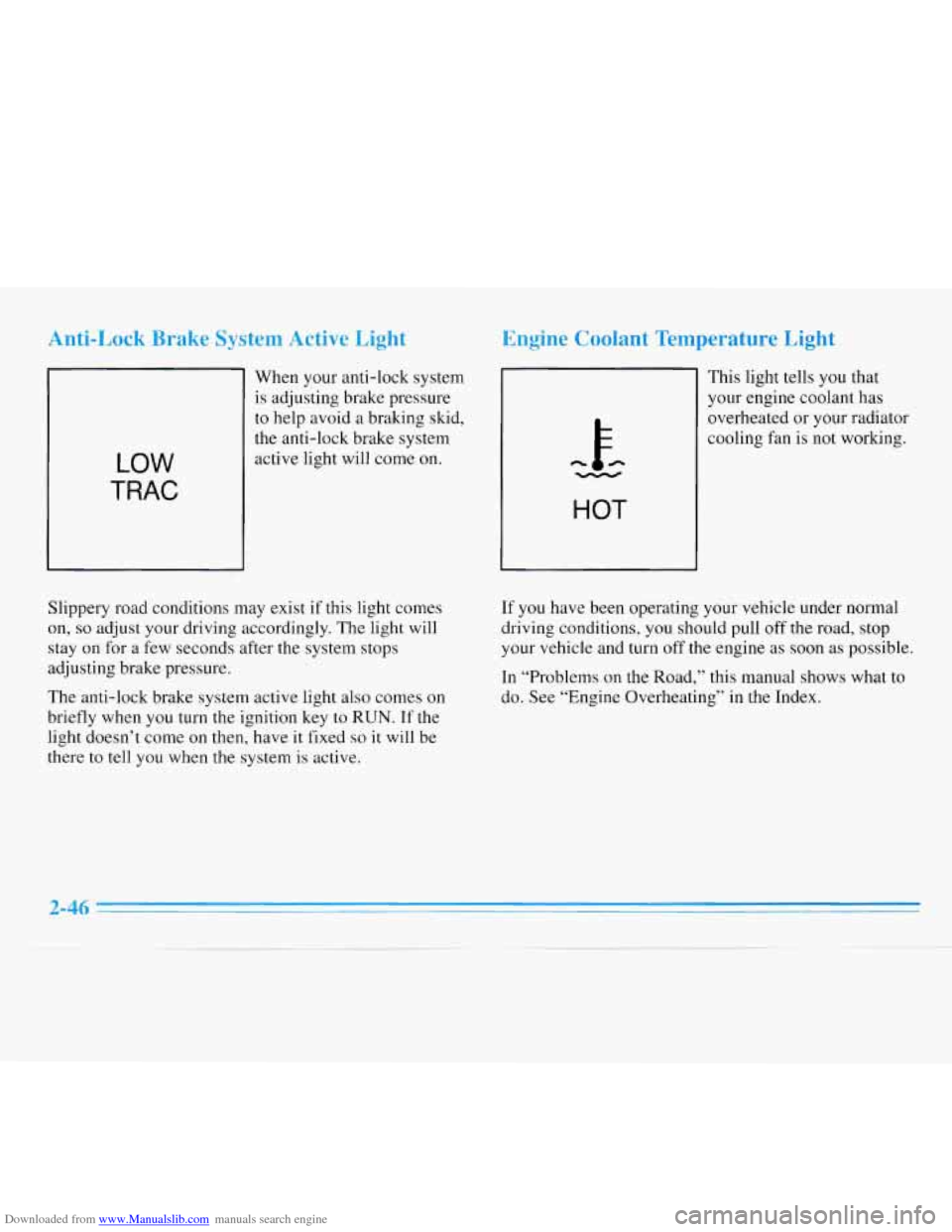1996 CHEVROLET MONTE CARLO brake light
[x] Cancel search: brake lightPage 10 of 340

Downloaded from www.Manualslib.com manuals search engine "-
Ihese are some of the symbols you may find on your vehicle.
hide Symbols
For example,
these symbols
are used
on an
original battery:
POSSIBLE A
CAUTION
INJURY
PROTECT EYES BY
SHIELDING
CAUSTIC
I
BURNS
I
AVOID
SPARKS
OR
FLAMES
SPARK
OR ,111,
1 FLAME
COULD
EXPLODE BATTERY
These symbols
are important for you and
your passengers
whenever your
vehicle
is
driven:
DOOR LOCK
UNLOCK
FASTEN SEAT
BELTS
POWER
WINDOW
These symbols have
to do with
your lights:
SIGNALS e
TURN
RUNNING
* 0
DAYTIME . . .
LAMPS
FOG LAMPS
$0
These symbols
are
on some of
your controls:
WINDSHIELD
WIPER
WINDSHIELD DEFROSTER
WINDOW
DEFOGGER
VENTILATING FAN
These symbols
are used
on
warning and
indicator lights:
COOLANT -
TEMP -
CHARGING I-]
BATTERY
SYSTEM
BRAKE
(a)
COOLANT a
ENGINE OIL w,
PRESSURE
ANTI-LOCK
(a)
BRAKES
1
Here arc some
other symbols
you
may see:
FUSE
P
LIGHTER
HORN
)tr
SPEAKER
b
FUEL 1
ii
Page 67 of 340

Downloaded from www.Manualslib.com manuals search engine If you accidentally use a key that has a damaged or
missing resistor pellet, the starter won’t work, and the
SECURITY light will come on. But you don’t have to
wait three minutes before trying another ignition key.
See your Chevrolet dealer or a locksmith who can
service the PASS-Key I1 to have a new key made.
If you’re ever driving and the SECURITY light comes
on and stays on, you will be able to restart your engine
if you turn it off. Your PASS-Key I1 system, however,
is not working properly and must be serviced by your
Chevrolet dealer. Your vehicle is not protected by the
PASS-Key
II system.
If you lose or damage
a PASS-Key I1 ignition key, see
your Chevrolet dealer or a locksmith who can service
PASS-Key I1 to have a new key made. In an emergency,
call the Chevrolet Roadside Assistance Program at
1-800-CHEV-USA
(1-800-243-8872).
New Vehicle “Break-In”
NOTICE:
Your modern Chevrolet doesn’t need an
elaborate “break-in.” But
it will perform better
in the long run if you follow these guidelines:
0 Don’t drive at any one speed -- fast or
slow
-- for the first 500 miles (804 km).
Don’t make full-throttle starts.
200 miles (322 km) or so. During this time
your new brake linings aren’t yet broken
in. Hard stops with new linings can mean
premature wear and earlier replacement.
Follow this breaking-in guideline every
time
you get new brake linings.
0 Don’t tow a trailer during break-in. See
“Tdwing
a Trailer” in the Index for more
information.
I
0 Avoid making: hard stops for the first
I 2-9 1
Page 87 of 340

Downloaded from www.Manualslib.com manuals search engine Here’s the second way to go to a higher speed:
Move the cruise switch from ON to R/A. Hold it
there until
you get up to the speed you want, and
then release the switch.
To increase your speed in very small amounts, move
the switch to
R/A for less than half a second and then
release it. Each time you do this, your vehicle will go
1 mph (1.6 km/h) faster.
The accelerate feature will only work after you set
the
cruise control speed by pushing the SET button.
Reducing Speed While Using Cruise Control
There are two ways to reduce your speed while using
cruise control:
Push in the SET button until you reach the lower
speed you want,
then release it.
0 To slow down in very small amounts, push the SET
button for less than half a second. Each time you do
this, you’ll go 1 mph (1.6 km/h) slower.
Using Cruise Control on Hills
How well your cruise control will work on hills depends
upon your speed, load and the steepness of tfie hills.
When going up steep hills, you may have to step on the
accelerator pedal
to maintain your speed. When going
downhill, you may have to brake or shift
to a lower gear
to keep your speed down. Of course, applying the brake
takes you out of cruise control. Many drivers find this to
be too much trouble and don’t use cruise control
on
steep hills.
Ending Cruise Control
There are two ways to turn off the cruise control:
Step lightly on the brake pedal; OR
Move the cruise switch to OFF.
Erasing Cruise Speed Memory
When you turn off the cruise control or the ignition, or
shift
into PARK (P) or NEUTRAL (N), your cruise
control set speed memory is erased.
Passing Another Vehicle While Using Cruise Control
Use the accelerator pedal to increase your speed. When
you take your foot
off the pedal, your vehicle will slow
down to the cruise control speed you set earlier.
2-29
Page 88 of 340

Downloaded from www.Manualslib.com manuals search engine Lamps
The lamp controls are on the instrument panel. They
control these systems:
Headlamps
Taillamps
0 Parking Lamps
License Lamps
0 Sidemarker Lamps
0 Instrument Panel Lamps
0 Courtesy Lamps
-g- Turn the knob to this symbol (C) to turn on the
headlamps and other operating lamps.
pf Turn the knob to this symbol (B) to turn on the
parking and other operating lamps without the
headlamps.
Turn the knob to
OFF to turn off the lamps.
A warning chime will sound when you turn
the ignition
switch to
OFF, LOCK or ACC with the lamps on.
"time Ru: ling Lamps (Canada Only)
mytime Running Lamps (DRL) can make it easier
for others to see the front of your vehicle during the
day.
DRL can be helpful in many different driving
conditions, but they can be especially helpful
in the
short periods after dawn and before sunset.
A light sensor on top of the instrument panel makes the
DRL work,
so be sure it isn't covered.
The DRL system will make your low-beam headlamps
come on
at a reduced brightness when:
0 The ignition is on,
0 The headlamp switch is off, and
0 The parking brake is released.
2-30
Page 102 of 340

Downloaded from www.Manualslib.com manuals search engine Brake System Warning Light
Your Chevrolet’s hydraulic brake system is divided into
two parts. If one part isn’t working, the other part can
still work and stop you. For good braking, though, you
need both parts working well.
If the warning light comes on, there could be
a brake
problem. Have your brake system inspected right away.
BRAKE
This light should come on
briefly when you turn the
ignition key
to RUN. If it
doesn’t come on then, have
it fixed so it will be ready
to warn you
if there’s a
problem.
If the light comes on while you are driving, pull
off the
road and stop carefully.
You may notice that the pedal is
harder to push. Or, the pedal may go closer to the floor.
It may take longer to stop.
If the light is still on, or if the anti-lock brake system warning light
is flashing, have
the vehicle towed for service. (See “Anti-Lock Brake
System Warning Light” and “Towing Your Vehicle” in
the Index.)
A
I
Your brake system may not be working properly
if the brake system warning light is on. Driving with the brake system warning light on can lead
to an accident. If the light is still on or if the
anti-lock brake system warning light is flashing
after you’ve pulled off the road and stopped
carefully, have the vehicle towed for service.
When the ignition is on, the brake system warning light
will also come on when you set your parking brake. The
light will stay on if your parking brake doesn’t release
fully. If it stays on after your parking brake is fully
released, it means you have a brake problem.
2-44
Page 103 of 340

Downloaded from www.Manualslib.com manuals search engine Anti-Lock Brake System Warning Light
ANTI -
LOCK
With the anti-lock brake
system, this light will come
on when you start your
engine and
it will stay
on for three seconds.
That’s normal.
If the light flashes when you’re driving, you don’t have
anti-lock brakes and there could be
a problem with your
regular brakes. Pull off the road and stop carefully. You
may notice that the pedal is harder to push. Or, the pedal
may go closer to the floor. It may take longer to stop.
Have the vehicle towed for service. (See “Towing Your
Vehicle”
in the Index.)
Your regular brake system may not be working
properly if the anti-lock brake system warning light
is flashing. Driving with the anti-lock brake system warning light flashing can lead to an accident. After
you’ve pulled
off the road and stopped carefully,
have the vehicle towed for service.
If the anti-lock brake system warning light stays on
longer than normal after you’ve started your engine, turn
the ignition
off. Or, if the light comes on and stays on
when you’re driving, stop
as soon as possible and turn
the ignition off. Then start the engine again
to reset the
system. If the light still stays on, or comes
on again
while you’re driving, your Chevrolet needs service.
If
the light is on but not flashing and the regular brake
system warning light isn’t
on, you still have brakes, but
you don’t have anti-lock brakes.
The anti-lock brake system warning light should come
on briefly when you turn the ignition
key to RUN. If the
light doesn’t come on then, have
it fixed so it will be
ready to warn you
if there is a problem.
Page 104 of 340

Downloaded from www.Manualslib.com manuals search engine Anti-Lock Brake System Active Light
LOW
TRAC
When your anti-lock system
is adjusting brake pressure
to help avoid a braking skid,
the anti-lock brake system
active light will come on.
Engine Coolant Temperature Light
This light tells you that
your engine coolant has
overheated or your radiator
HOT
cooling fan is not working.
Slippery road conditions may exist if this light comes
on, so adjust your driving accordingly. The light will
stay on for a few seconds after the system stops
adjusting brake pressure.
The anti-lock brake system active light also comes on
briefly when you turn the ignition key to RUN. If the
light doesn’t come on then, have it fixed
so it will be
there
to tell you when the system is active. If
you have been operating your vehicle under normal
driving conditions,
you should pull off the road, stop
your vehicle and turn off the engine as soon
as possible.
In “Problems on the Road,” this manual shows what to
do. See “Engine Overheating”
in the Index.
Page 142 of 340

Downloaded from www.Manualslib.com manuals search engine Avoid needless heavy braking. Some people drive in
spurts
-- heavy acceleration followed by heavy
braking
-- rather than keeping pace with traffic. This is a
mistake. Your brakes may not have time to cool between
hard stops. Your brakes will wear out much faster
if you
do a lot
of heavy braking. If you keep pace with the
traffic and allow realistic following distances, you
will
eliminate a lot of unnecessary braking. That means
better braking and longer brake life.
If your engine ever stops while you’re driving, brake
normally but don’t pump your brakes. If you do, the
pedal may get harder to push down.
If your engine
stops, you will still have some power brake assist. But
you will use it when you brake. Once the power assist is
used up, it may take
longer to stop and the brake pedal
will be harder to push.
Anti-Lock Brakes
Your vehicle has anti-lock brakes (ABS). ABS is an
advanced electronic braking system that will help
prevent
a braking skid.
When you start your engine, or when you begin to drive
away, your anti-lock brake system will check itself. You
may hear a momentary motor or clicking noise while
this test
is going on, and you may even notice that your
brake pedal moves
a little. This is normal.
ANTI -
LOCK
If there’s a problem with the
anti-lock brake system, this
warning light will stay on
or flash. See “Anti-Lock
Brake System Warning
Light”
in the Index.